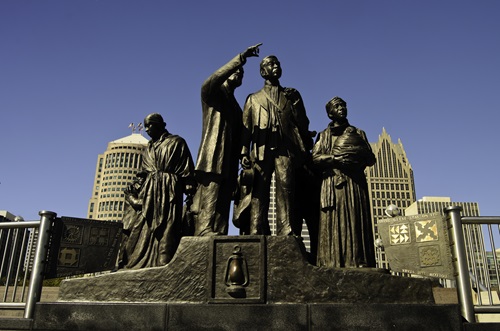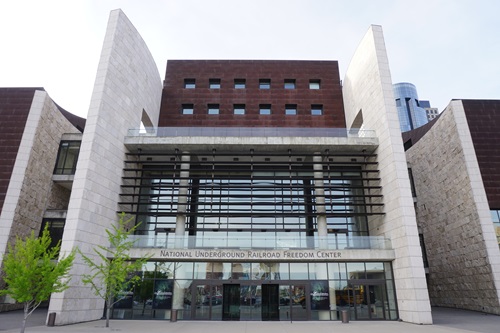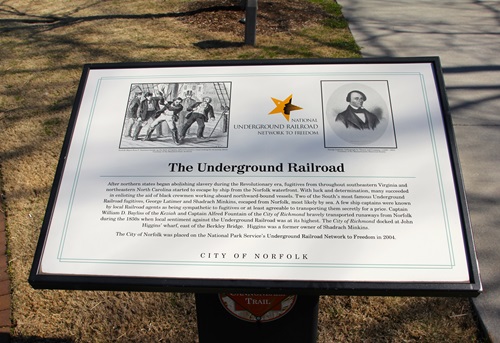
In Kansas, the Chris Barr Old Log Cabin was a key site on the Underground Railroad. The cabin had a small loft area that runaway slaves could access through a faux cabinet, allowing them to hide during the day. There was also a trap door in the floor. Photo © Lisa Mckown | Dreamstime.com
We already know that nostalgia tourism, including educational and historical travel, has become a factor in sports tourism, but a key piece of funding by the National Park Service (NPS) could generate even more interest in certain places. A total of 20 Underground Railroad sites in 14 states, once developed, could bring increased tourism as a result of educational interests.
And that's just the beginning; the NPS is looking for information on other sites throughout the U.S., providing an opportunity for destinations to tell their stories. More information on that can be found near the end of this article; however, in the meantime, here is what other states are doing.
The NPS has awarded $500,000 in grants to a variety of research, preservation and outreach activities related to the Underground Railroad and freedom seekers. In collaboration with the Association for the Study of African American Life and History (ASALH), the grants were distributed through a competitive process to 20 current or prospective NPS Underground Railroad Network to Freedom Program members in 14 states.
“These grants are vital to uncovering and sharing previously untold stories related to our country’s history,” said National Park Service Director Chuck Sams. “They help expand public awareness, connect us with our shared heritage, and provide a more complete and inclusive account of our evolution as a country.”
The funds will support projects that enhance the preservation or interpretation of sites with verifiable connections to stories of enslaved persons seeking freedom, including the Underground Railroad, one of the nation’s earliest civil rights movements. The projects include preservation of Underground Railroad sites, development of Underground Railroad curriculum, collection of information about freedom seekers who joined the Union Army, and research on self-emancipation in Sacramento during the California Gold Rush.
Connecticut Museum Quest notes that In many cases, states have tried to pinpoint exact locations used by the Underground Railroad; however, the difficulty lies in the fact that absolute secrecy was necessary among those participating, since it was a crime to aid or abet escaped slaves. As a result, information regarding many locations used in the Underground Railroad was never printed, and has been lost to history, surviving only in oral tradition.
According to the Chester County, Pennsylvania website, The Underground Railroad was a secret network of courageous people … who broke the law to offer transportation, refuge, food and comfort to escaping slaves during the 1700s and early 1800s. While it wasn't literally a railroad, it was named symbolically after the new steam trains and used terms such as "passengers," "depots," and "conductors."
The grantees were selected based on their competitive ranking from an application pool that included over $1.7 million in project requests. Grants were available only to designated Network to Freedom program member sites, facilities, and programs, as well as organizations seeking to document Underground Railroad history.
The Network to Freedom Program honors, preserves, and promotes the history of resistance to enslavement through collaboration with individuals, organizations, local, state and federal entities. It has more than 800 listings, all with verifiable connections to the Underground Railroad. These listings are catalysts for innovation, partnership and scholarship that advances the right to self-determination and freedom from oppression for all people.

“The Association for the Study of African American Life and History salutes the 2024 Network to Freedom grantees for perseverance in disseminating knowledge of the African American experience as it involves the Underground Railroad and its vast tentacles of freedom,” said ASALH Executive Director Sylvia Cyrus. “In the spirit of Dr. Carter G. Woodson, the founder of ASALH, who observed that ‘Knowledge is power,’ the research, public discourse and collaboration with diverse partners helps different communities discover history related to their community as well as surrounding communities.”
The grant recipients by state are:
California
- $14,000 to the Sacramento Network to Freedom Trail Project to prepare a nomination for a Network to Freedom listing for the site of St. Andrews AME and Hacket House.
Connecticut
- $5,000 to William Grimes Grave Site in Grove Street Cemetery to prepare a new nomination for a Network to Freedom listing.
Florida
- $37,700 to the Angola Maroon Community for a comic book educating children about the maroon community.
Florida’s history with the Underground Railroad is by turns both complicated and fascinating, according to Visit Florida. In fact, centuries before the advent of Harriet Tubman, enslaved people sought freedom via another Underground Railroad—one that traveled from North to South. Enslaved people from modern-day Georgia and the Carolinas journeyed to Florida in search of freedom.
Georgia
- $5,000 to the McDonough Memorial Cemetery to write a nomination for a new Network to Freedom listing.
Illinois
- $35,000 to the Lucius Read House for a roof replacement and exterior preservation.
- $3,559 to the Bristol Congressional Church for a new sign.
Iowa
- $1,800 to Winterset “Old Log” Jail for a new sign.
Kansas
- $15,688 to Constitution Hall in Topeka to build a digital presence through a website and social media.
Maryland
- $13,138 to Maryland State Archives to complete a research project called Revolts and Rebellions: Absconding from Slavery project. They will recognize freedom efforts and their consequences between Nat Turner’s 1831 Rebellion, the 1850 Fugitive Slave Act, and the 1851 Christiana Revolt.
- $64,148 to Button Farm Almanac Tour to create an audio tour to accompany the in-person guided almanac tour.
- $30,000 to Mount Clare to expand curriculum regarding primary sources used in Underground Railroad research, along with information about the historic train station, that provide educational opportunities for students and teachers.
Worth noting: The Maryland DNR website states, “The 17-acre Harriet Tubman Underground Railroad State Park and Visitor Center invites visitors to experience Tubman’s world through exhibits that are informative and emotive, providing an in-depth understanding of Tubman’s early years spent in Maryland's Choptank River region and her legacy as a leader, liberator and humanitarian in the resistance movement of the Underground Railroad. The park, which sits on the trailhead for the 125‐mile Harriet Tubman Underground Railroad Byway (an All American Road) also provides an orientation to Tubman and Underground Railroad heritage sites and programs within the county and region.”
Massachusetts
- $53,469 to the Samuel May House for a historic structures report to assess their priorities regarding preservation of the building.
Michigan
- $8,400 to the Creating Teacher Storytellers: Reviewing Local Evidence of the John White Story for an interpretation project.
There are 34 confirmed sites in Michigan linked to the Underground Railroad, and likely many more unofficial sites that aided in the network to help enslaved people seek freedom. Michigan was often a last stop on the journey north to Canada, which ended slavery nearly 30 years before the United States, according to Michigan’s website.

Missouri
- $6,000 to Mount Pleasant Baptist Church and Cemetery for a research project about eight enslaved men who joined the United States Colored troops.
- $99,920 for an interpretation project at the Tower Grove House at Missouri Botanical Garden.
- $16,604 for signage at the Smith Cemetery.
Worth noting: Slave cemeteries, and even old burying grounds for free Black individuals, have long been hard to locate and over the years, the land has often been used for commercial development. - $4,000 for a research project at the Missouri River Crossing of Sixteen Enslaved Men at Howell’s Ferry.
New York
- $73,214 for the Cataract House site to conduct archaeological excavation and research about Underground Railroad activism in Niagara Falls.
The I LOVE NY website notes, “Today, you can visit New York's Underground Railroad system from Brooklyn to Buffalo and everywhere in between, discovering the stories behind America's bravest abolitionists along the way. From The Harriet Tubman National Historic Park to the North Star Underground Railroad Museum to the Niagara Falls Underground Railroad Heritage Center to the John W. Jones Museum in Elmira, there are many ways to learn about New York State’s and New Yorkers’ role in the Underground Railroad.
Visitors should not miss the newly-launched trail "Travel with Tubman", a National Parks Service initiative that guides visitors through eight states and 13 historic Harriet Tubman sites of significance, including six New York State historic sites. For additional information, please visit the New York State Department of Parks, Recreation and Historic Preservation Underground Railroad page. Also, watch a panel discussion with top experts from Underground Railroad attractions to learn even more.”
North Carolina
- $11,000 for an interpretive monument and landscaping at Water Street Landing Park.
WRAL News states, “When visiting North Carolina’s idyllic little coastal communities, visitors may not expect that some of those quaint riverside buildings once held secret passageways and smuggling tunnels. Enslaved men and women escaping from large plantations in Raleigh or farther west would often float down rivers and tributaries – bodies of water known as "Freedom Roads" that eventually led to coastal towns, where they could catch a ship up north to freedom.”
Texas
- $2,320 for new wayside exhibit and outreach materials for the Jackson Ranch Church and Martin Jackson Cemetery.

Some states are not on the list above but played essential roles in the Underground Railroad. As the Chester County website notes, there is a robust Underground Railroad infrastructure. The Harriet Tubman Underground Railroad Freedom Trail is now a byway — the Harriet Tubman Underground Railroad Byway, with Maryland and Delaware Harriet Tubman Underground Railroad Byways extended to Pennsylvania. The Byway connects over 200 miles of sites in Delaware and Maryland, with sites in Chester County and beyond to Delaware County in Pennsylvania and Independence Mall in Philadelphia. The Byway is also extending further north to sites in New York.
Wilmington, Delaware was another critical link in the Underground Railroad network of the Northeastern U.S. Sites depicted have documented association with UR and abolitionist activities. The sites generally overlap with the Harriet Tubman Underground Railroad Byway.
The National Park Service believes that much of the Underground Railroad has yet to be explained to today’s visitors, and that many stories have not been as widely told as they deserve. As a result, it is encouraging contact from destinations or entities wishing to highlight a place or a story that played a role in the Underground Railroad. Contact information for the NPS can be found here.

